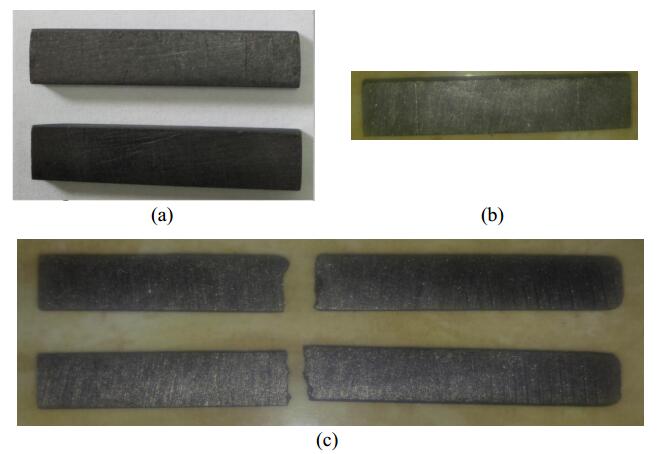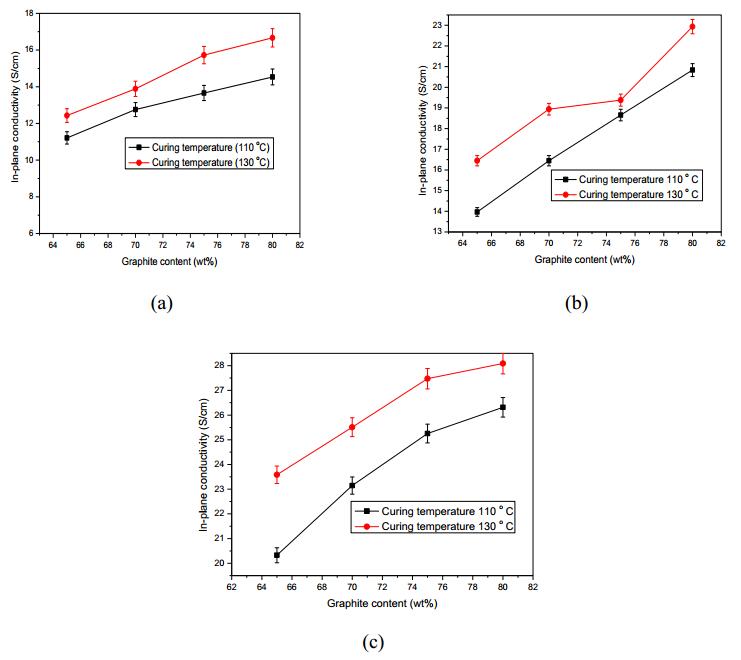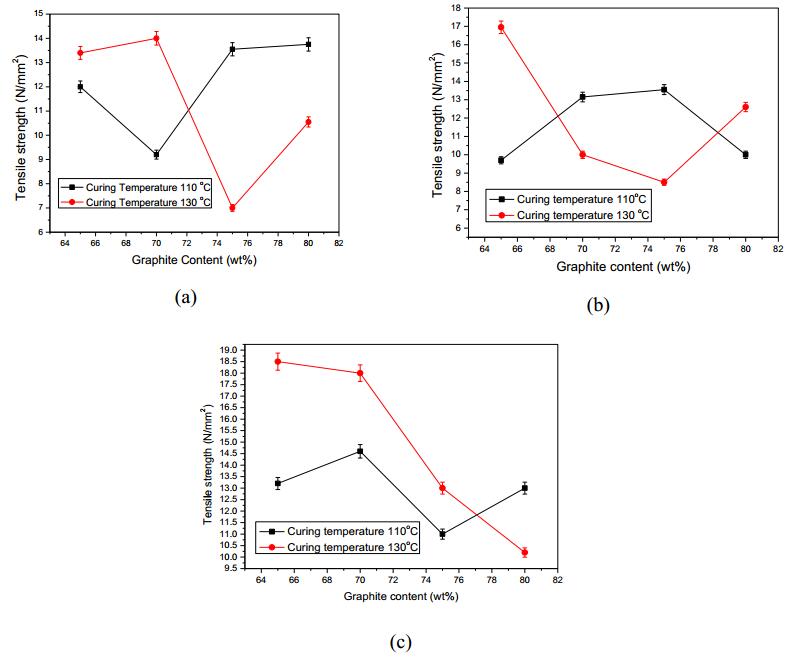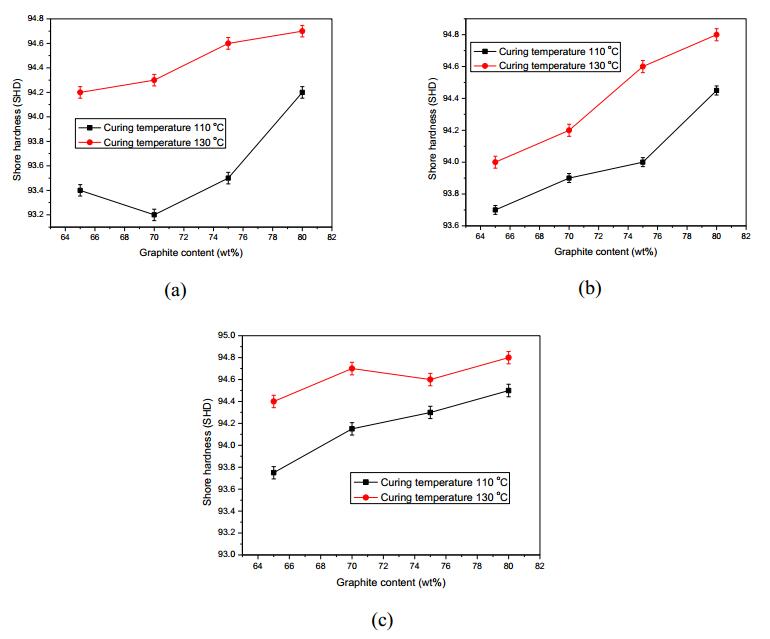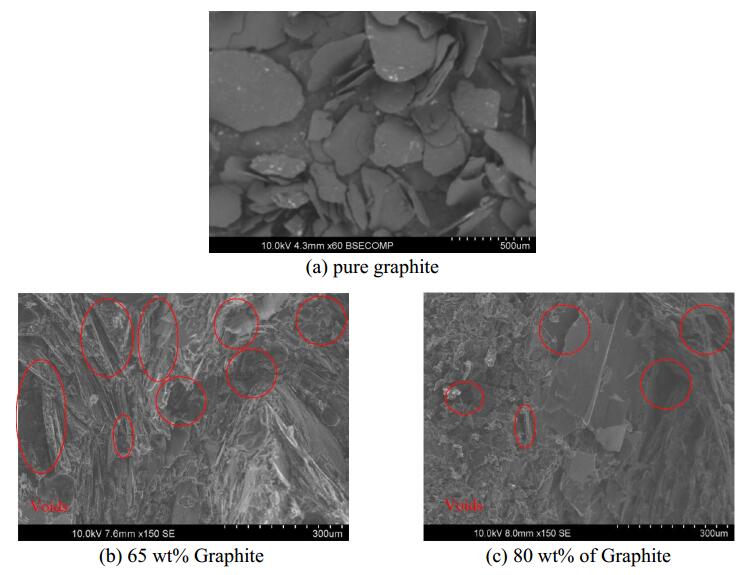Graphite/epoxy composites have the potential to be used as conductive polymer composites (CPCs). Nevertheles, graphite/epoxy composites have a low in-plane conductivity, so a large amount of conductive filler is needed to increase the in-plane conductivity. However, other composite properties can be affected if the conductive filler content is too high. The casting method was used to produce graphite/epoxy composites in this study. Graphite was added to an epoxy resin at various weight percentage (wt%), curing times, and curing temperatures. The result show that a graphite/epoxy composite with 80 wt% of graphite at curing temperature of 130 ℃ and a curing time of 120 minutes produce the highest in-plane conductivity and shore hardness of 28 S/cm and 94.88 SHD, respectively. In contrast, the highest tensile strength of the graphite/epoxy composite (18.5 N/mm2) was obtained with 65 wt% of conductive filler material, the lowest amount considered in this study. This is due to the reduced ability of epoxy resins to bind to higher amounts of conductive fillers (e.g., 80 wt%).
1.
Introduction
The in-plane conductivity of a conductive polymer composite (CPC) is greatly influenced by the composition and dispersion of conductive filler. However, the mechanical properties and manufacturing processability of the polymer composite degrade if the conductive filler content is too high [1,2,3]. Based on these conditions, it is necessary to achieve an appropriate balance between the conductive filler and polymer matrix to obtain good electrical conductivity and mechanical properties in CPC. Several kinds of conductive fillers have been used by researchers in previous studies, such as carbon nanotubes (CNTs), graphene, carbon black (CB), and carbon fibres (CFs), to obtain desired properties, such as fire-retarding properties, good thermal conductivity, electrical conductivity, and mechanical properties, and the ability to enable oxygen reduction reactions [4,5,6,7,8,9,10,11].
Hui et al. [12] and Jing et al. [13] conducted research on graphite to determine the influence of the particle size on the electrical conductivity of composite materials. The results showed that an increase in the graphite particle size could increase the in-plane conductivity of the composite. A similar result was also obtained by Chunhui et al. [14] for sodium silica/graphite and aluminium cement/graphite composites. The results showed that a high amount of conductive filler within the polymer matrix will generate a high contact among conductive particles, thereby increasing the electrical conductivity of the CPCs. Dhakate et al. [15] used 60 to 80 vol% synthetic graphite (SG) and natural graphite (NG) as a conductive filler for a bipolar plate material and showed that 80 vol% graphite conductive filler produced the phenolic resin with the highest electrical conductivity compared to that of filler amounts below 80 vol%. This study used various weight percentages (wt%) of graphite in CPCs to investigate the in-plane conductivity, tensile strength, and Shore hardness of graphite/epoxy composites.
2.
Materials and methods
2.1. Material
This study used graphite (purchased from Asbury Carbons) as a single conductive filler with an average particle size of 150 µm. An epoxy resin with a viscosity of 6 poise (635 thin) was purchased from US Composites. Graphite was chosen as a conductive filler in the CPCs because of its high electrical conductivity and different size and shape. Moreover, graphite is easily formed by conventional processes, such as casting.
2.2. Preparation graphite/epoxy composites
In the first stage, a mechanical mixer was used to mix epoxy resin and hardener at a ratio of 4:1 in wt%. Next, various concentrations of graphite were added to the mixture of epoxy resin and hardener. Then, this mixture was stirred again at 200 rpm for 10 minutes using a mechanical mixer (RW 20-KIKA-WERK). In the final stage, the composite mixture was poured into an aluminium mould for casting for a particular curing time (60, 90,120 minutes) and curing temperature (110 ℃ and 130 ℃).
Table 1 shows the weight percentages (wt%) of epoxy and graphite. The use of a high-conductive filler material in the epoxy resin matrix is necessary to obtain the optimal balance between the in-plane conductivity and the mechanical properties of the graphite/epoxy composite; in this case, the most important mechanical properties are the tensile strength and Shore hardness.
2.3. Characterizations
The in-plane conductivity of the CPCs was measured according to ASTM C 61, while the Shore hardness was measured by a Shore hardness tester (TIME 5420). The tensile strength was measured according to ASTM D 3039. The graphite shape and fracture surface of the graphite/epoxy composite produced were observed using scanning electron microscopy (SEM) with a Hitachi S-3400 N instrument. The research specimens are shown in Figure 1.
3.
Results and discussion
3.1. Effect of graphite content on the in-plane conductvity
Figure 2 shows the effect of adding conductive filler to the matrices (65, 70, 75 and 80 wt%) at different curing temperatures (110 ℃ and 130 ℃) and curing times (60, 90 and 120 minutes) on the in-plane conductivity of the graphite/epoxy composites. These figures show that the in-plane conductivity increases concurrently with an increasing filler loading concentration (65, 70, 75, and 80 wt%), curing time (60, 90 and 120 minutes) and curing temperature (110 ℃ and 130 ℃) of the graphite/epoxy composite.
Conductive networks within an epoxy resin matrix increase with an increasing graphite loading concentration, so the resulting in-plane conductivity of the graphite/epoxy composite also increases [1,16]. Increasing the curing time increases the in-plane conductivity of the graphite/epoxy composites. The highest in-plane conductivity (28 S/cm) was produced with a curing time of 120 minutes. This is because the conductive filler requires time to be properly dispersed in the matrix [1,17,18]. The research results show that the curing temperature also influences the in-plane conductivity of the composite material. The higher curing temperature (130 ℃) shows a higher in-plane conductivity (Figure 2). An increasing curing temperature (from 110 ℃ to 130 ℃) causes a reduction in the viscosity of the epoxy resin, making it easier for graphite to form a conductive network in the matrix, which leads to a higher in-plane conductivity [2,18]. The results show that the highest in-plane conductivity (28 S/cm) was reached at the highest curing temperature (130 ℃) and the highest curing time (120 minutes).
3.2. Effect of graphite content on tensile strength
The effect of the graphite content on the tensile strength of the graphite/epoxy composites with various weight percentages (wt%), curing times (60, 90, and 120 minutes) and curing temperatures (110 ℃ and 130 ℃) is shown in Figure 3.
The tensile strength increased with increasing curing time (at a curing temperature of 130 ℃ and graphite content of 65 wt%). The tensile strength increased from 14 N/mm2 (60 minutes curing time) to 18.5 N/mm2 (120 minutes curing time). The tensile strength reached 18.5 N/mm2 at a higher curing temperature of 130 ℃. However, a lower curing temperature of 110 ℃ also generated a lower tensile strength of 13 N/mm2 for the same graphite load and curing time (65 wt% and 120 minutes) (see Figure 3c). This is because a sufficient curing time is needed to produce a good graphite/epoxy composite [18,19].
3.3. Effect of graphite addition on Shore hardness
Figure 4 shows the effect of adding graphite at different curing times and curing temperatures on the Shore hardness. The lowest Shore hardness (93.43 SHD) occurred for the lowest amount of graphite (65 wt%), lowest curing temperature (110 ℃), and lowest curing time (60 minutes), while the highest Shore hardness (94.88 SHD) occurred for the highest content of graphite (80 wt%), highest curing temperature (130 ℃), and highest curing time (120 minutes).
The highest Shore hardness was obtained at the highest graphite content due to graphite having a higher hardness than epoxy; thus, increasing the graphite content increases the Shore hardness of the composite. The Shore hardness also increases with increases in the curing temperature and curing time. This is related to the dispersion of graphite in the polymer matrix, which is affected by the curing time and curing temperature [16,19]. Evenly dispersed graphite increases the Shore hardness of the composite.
3.4. Fracture surface of graphite/epoxy composites
Scanning electron microscopy (SEM) images of the graphite/epoxy composite fracture surface are shown in Figure 5. Figure 5a shows the type of graphite used (spherical shape), and Figure 5b shows that graphite conductive filler with 65 wt% loading concentration is capable of filling the entire polymer matrix; however, many gaps or voids are formed, and thus, the resulting in-plane conductivity and Shore hardness of the resulting graphite/epoxy composite are low [3,20]. Figure 5c shows that the existing voids are substantially reduced due to the high amount of graphite content (80 wt%); the graphite occupies the entire area of the polymer matrix, causing the void content to decrease, and thus, the in-plane conductivity and Shore hardness can increase [3,21,22].
4.
Conclusion
This study shows that the in-plane conductivity, tensile strength, and Shore hardness of the produced conductive polymer composites were influenced by the addition of graphite, curing temperature, and curing time. The graphite/epoxy composites at 80 wt% graphite, a curing temperature of 130 ℃, and a curing time of 120 minutes provided the highest in-plane conductivity (28 S/cm) and highest Shore hardness (94.88 SHD) of the samples considered in this study. However, the highest tensile strength was obtained with the lowest amount conductive filler considered (65 wt% of graphite), which was 18.5 N/mm2. This is because the matrix was not strong enough to bind the conductive filler at a high load (80 wt%).
Acknowledgement
The author would like to express gratitude for the financial support from the Directorate General of Higher Education for this work through the excellent research of the university with contract no. 001/Add/Research Contract/K10/KM/2017. Thanks are also owed to the Overseas Seminar Aid Program, Directorate General of Research and Development Strengthening, Indonesia Ministry of Research Technology and Higher Education on 2017.
Conflicts of interest
There are no conflicts to declare.









 DownLoad:
DownLoad:







